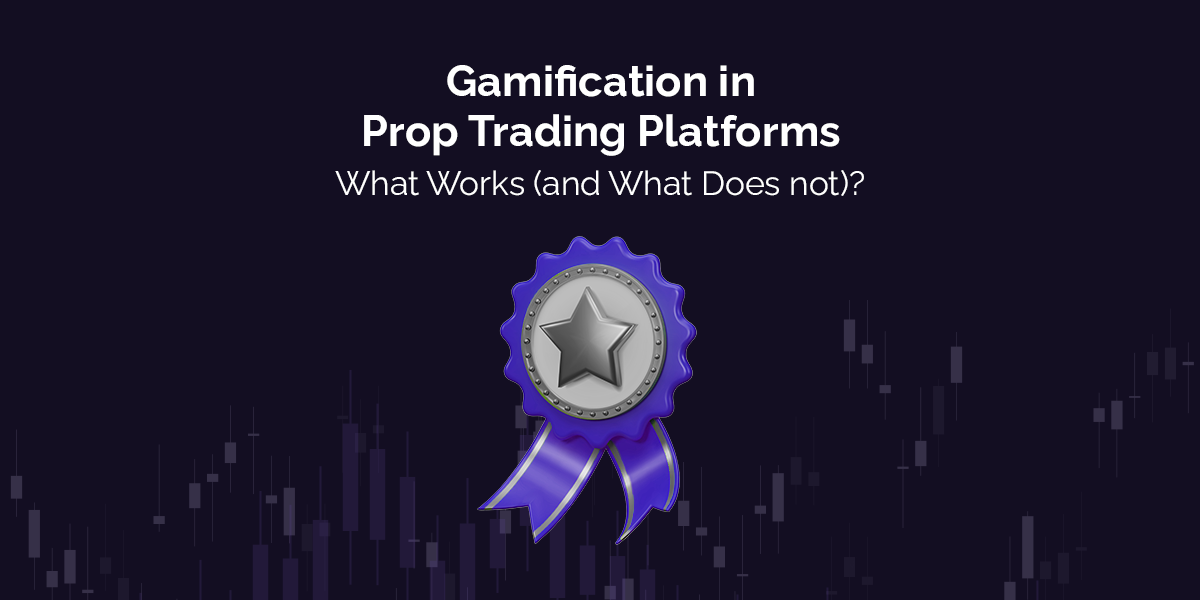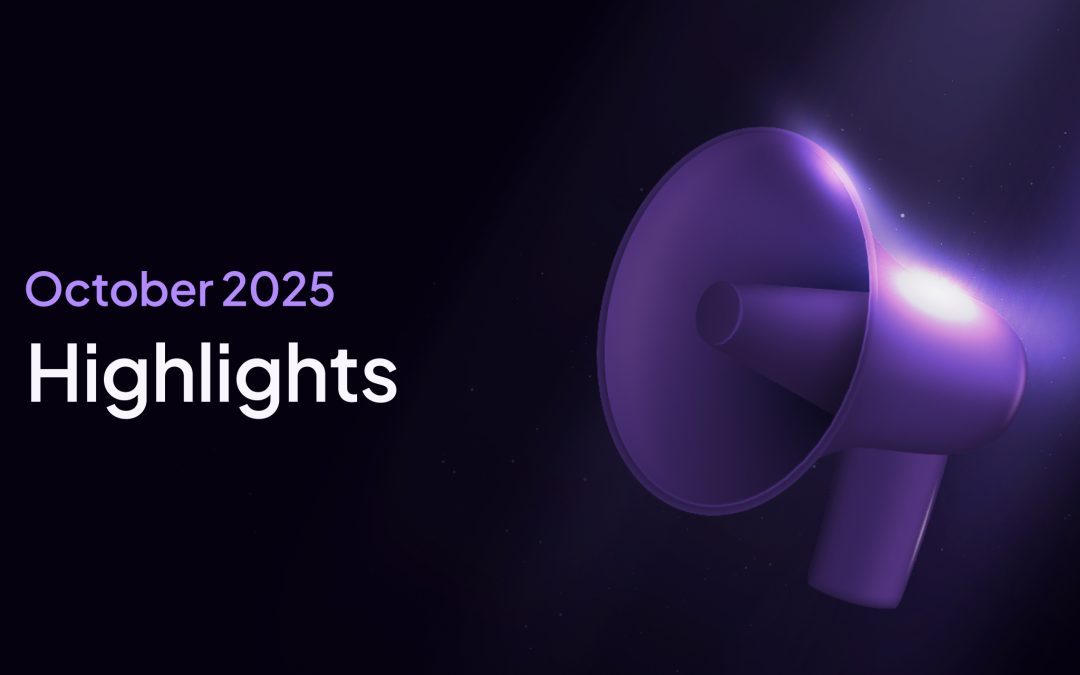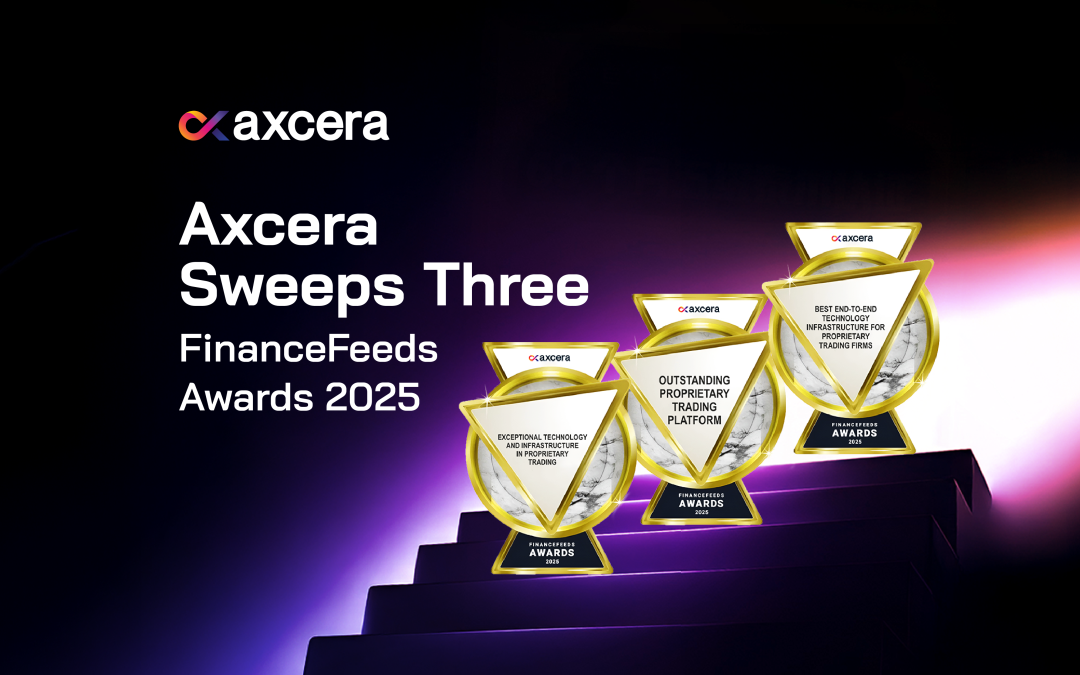Introduction: Turning Trading into a Game
Gamification, the application of game elements in non-game contexts, has made its way into proprietary trading platforms. In simple terms, gamification means adding features like points, levels, challenges, or rewards to make a normally serious activity more engaging. In trading, this could mean using trader engagement tools such as leaderboards, achievement badges, competitions and challenge-based rewards to motivate traders. The goal is to make the trading experience more interactive and enjoyable, especially for newcomers who might find traditional trading intimidating or dull.
However, “gamification in prop trading” is a double-edged sword. On one hand, it promises higher engagement, learning opportunities, and a sense of community among traders. On the other hand, if overdone or misapplied, it can encourage reckless behavior, turning trading into something that feels like a video game. In this article, we will explore what gamification elements work well in prop trading platforms, how they impact trader performance and retention, and how to implement them responsibly without undermining risk management or trading discipline.
Gamification in Prop Trading: What Does It Mean?
In the context of proprietary trading firms (prop firms), gamification refers to incorporating game-like features into trading platforms or programs. This can range from simple additions like points and badges for hitting certain milestones, to full-fledged trading competitions and “quests” for traders. The idea stems from a broader trend across industries: applying game design techniques to boost user engagement. For example, personal finance apps use game elements to encourage saving and investing habits.
In prop trading platforms, gamification often takes forms such as:
- Leaderboards and Rankings: Public or private leaderboards that display top-performing traders, fostering friendly competition.
- Achievement Badges: Visual badges or titles awarded for accomplishments (e.g. consecutive profitable days, risk management achievements, completing training modules).
- Challenges and Quests: Structured trading challenges (daily, weekly, or monthly) where traders aim to meet specific goals or pass an evaluation. Successful completion might unlock rewards like funded accounts or prize money.
- Points and Levels: Systems where traders earn points for various activities (like profitable trades, low risk scores, or participation) which accumulate to higher “levels” or statuses on the platform.
- Community Competitions: Tournaments or team-based contests where traders compete for rankings or rewards, adding a social and collaborative element.
These gamification features are essentially trader engagement tools designed to motivate participation. They tap into human psychology, our competitive streak, desire for recognition, and love of rewards, to keep traders active and invested in the platform.
What Gamification Elements Work Well?
Not all game-inspired features are created equal. The most effective gamification elements in trading are those that genuinely enhance the trading experience and skill development, rather than distracting from them. Based on real-world examples and industry insights, the following elements have proven to work well:
1. Leaderboards and Friendly Competition
Leaderboards are a classic gamification tool that rank traders by performance (e.g. monthly profit, win rate, or other metrics). Many prop trading platforms have introduced leaderboards or tournaments to create a sense of competition. This feature works because it appeals to competitive personalities and provides social recognition for top performers. For instance, many platforms center their model on competitions, traders pay an entry fee to compete in trading contests for cash prizes. By combining trading with competitive gameplay, they make the experience more exciting and community-driven. Leaderboards can spur traders to stay engaged and strive for improvement in order to “climb the ranks.”
There is evidence that leaderboards and competitions can boost engagement: they give traders a clear goal (beat your peers or your own past performance) and a dynamic environment that is constantly changing. By blending competitive elements with trading, platforms create “an ecosystem that attracts a diverse audience” and keeps users coming back. A healthy dose of competition can encourage traders to refine their strategies and learn from the top performers on the leaderboard.
That said, leaderboards should emphasize skill and consistency over pure profit-chasing. A leaderboard that only rewards highest short-term gains might tempt some users to take outsized risks (more on that in the caution section). The most effective use of leaderboards is to celebrate good trading habits and consistent performance, not just lucky wins.
2. Achievement Badges and Milestones
Achievement badges are digital rewards or icons that traders earn for reaching predefined milestones or completing specific actions. For example, a platform might award a badge for “Risk-Control Pro” when a trader sticks to a preset risk limit for a month, or a badge for completing all educational modules in the platform. These badges serve as both a reward and a visual record of accomplishment, which can be highly motivating.
Research on gamification has found that points, badges, and similar rewards can reinforce positive behaviors and keep users engaged. In trading platforms, badges can encourage traders to pursue beneficial activities like practicing on a simulator, using stop-loss orders consistently, or maintaining discipline during a volatile market. They act as engagement tools that fulfill the human need for achievement and recognition.
One real-world success story is how some brokerages gamify investor education. By giving badges or points for completing learning courses or quizzes, they incentivize traders to improve their knowledge. Not only does this keep users active on the platform, but it potentially makes them better traders in the long run. Well-designed achievement systems can refocus traders on skill development and continuous learning.
3. Challenge-Based Rewards (Trading Challenges)
Trading challenges are at the heart of most modern prop trading firms. Typically, a firm will have an evaluation program where traders must hit certain targets (and obey risk rules) over a period to get a funded account. This itself is gamification, a quest structure where the trader “levels up” by passing the challenge and earning a reward (funded capital or profit-sharing). Platforms have built on this by adding even more game mechanics: time-limited challenges, scaled difficulty levels, or retry options akin to extra lives.
For example, some prop firms take challenges to the next level by hosting paid-entry competitions in which traders compete to rank highest and win cash payouts. Unlike a traditional demo account, this model directly gamifies the trading experience and it is like entering a tournament. This works well to attract new traders who enjoy a competitive, goal-oriented format. Such competition-driven structure can improve dramatically the experience and engagement of traders by offering immediate, tangible rewards for skills.
Other prop firms use challenge-based gamification in more educational ways, for instance: monthly trading games where the top performers get fee rebates or recognition, or simulated trading contests for beginners to practice without real risk. Challenges are effective because they provide structure and motivation. Instead of aimless trading, participants have a clear objective and a prize at stake, which can drive them to put in more effort and focus.
Key to success: challenges should be designed with fairness and learning in mind. That means setting realistic objectives and enforcing risk management rules. A challenge that rewards a trader for, say, doubling an account in a week could encourage dangerous and toxic behavior; whereas a challenge that rewards achieving a steady percentage of return with limited drawdowns promotes good trading habits. The best challenge-based rewards strike a balance between being exciting and being prudent.
4. Community and Social Gamification
An often overlooked but powerful gamification element is the community aspect, turning trading from a solitary activity into a social, collaborative experience. Features like team-based challenges, trader chatrooms or forums, and social sharing of achievements all fall under this category. While not “game” features in the traditional sense, they leverage the social motivations of users (competition, cooperation, status seeking) which are very much part of gaming culture.
For instance, some trading platforms introduce team vs. team tournaments or allow traders to form leagues. This can drive engagement as traders encourage each other and hold teammates accountable. Social leaderboards (e.g., compare with friends or within a group) make competition more relatable. Moreover, sharing one’s progress or badges on social media can create a viral loop, bringing in new users and building brand awareness.
As Axcera’s core audience (prop trading firm operators) would know, fostering a community can significantly increase retention. Traders are more likely to stick with a platform where they feel a sense of belonging or friendly rivalry. Gamification that connects users rather than isolating them, often works best for long-term engagement. It turns the platform into not just a tool for trading, but a lively environment where traders can learn from each other and celebrate wins together.
Benefits: How Gamification Impacts Engagement and Performance
When implemented thoughtfully, gamification can have a positive psychological and operational impact on a prop trading business. Here are a few key benefits:
- Higher Trader Engagement: Game elements provide continuous stimuli and feedback. Earning points, unlocking a new level, or seeing your name on a leaderboard all create small “wins” that make traders more likely to log in regularly. Gamification enhances user engagement by introducing incentives and a sense of progress that traditional platforms lack. A more engaged trader is typically more active, meaning higher trading volume and participation on the platform, a plus for the prop firm’s ecosystem.
- Better Retention and Loyalty: Keeping traders interested and engaged over the long term is a challenge for any prop firm. Gamified platforms often report improved user retention. The reason is straightforward, if the experience is enjoyable and rewarding (not just financially, but psychologically), traders have more reasons to stick around. Achieving a new badge or maintaining one’s leaderboard position can become goals that complement the financial motivations. Gamification adds an element of fun and personal investment in the platform, making users less likely to churn.
- Accelerated Learning and Skill Development: Surprisingly, turning trading into a bit of a game can help traders learn faster. Educational gamification like quizzes, interactive tutorials, or simulated trading games, can improve understanding and confidence in traders. By removing the fear of failure and framing learning as play, new traders are more inclined to practice and absorb knowledge. Industry experts have drawn parallels to language-learning apps: just as Duolingo uses streaks and badges to motivate learners, a prop trading platform can use them to encourage learning about risk management or new strategies. Some platforms integrate gamified training modules, rewarding users for expanding their skills. This not only produces more competent traders (a win for both the trader and firm) but also helps fulfill the promise that prop trading firms often make, to be a talent incubator and education provider, not merely a broker.
- Community Building and Healthy Competition: Gamification can cultivate an active community around a trading platform. Features like community leaderboards, team challenges, or social badges (e.g., “Early Adopter” or “Top Mentor” badges) recognize contributors and encourage interaction. A strong community leads to higher engagement: traders log in not just to trade, but to see what others are doing, discuss markets, or compete in a friendly way. This network effect is valuable for operators because it creates loyalty that is not solely tied to monetary outcomes. In other words, even if a trader has a tough month in the market, they might remain with the platform because they value the community and the gamified experience.
- Behavioral Insights for the Firm: Every point or badge earned is data. Gamification features give prop firm operators more granular insight into user behavior and preferences. For example, if a large portion of traders consistently fails a particular challenge level, it may indicate something about that challenge’s difficulty or about a common weakness in strategy. Operators can adjust programs or offer targeted coaching, thus improving the overall performance of their traders. Additionally, tracking engagement with gamified elements helps identify who your most active or motivated traders are, valuable for talent scouting in a prop firm context.
It is important to note that these benefits only fully materialize when the gamification is designed well. Traders still prioritize making real money and managing risk; the gamified layer should support those goals, not overshadow them. Next, we will examine the potential downsides when gamification is misused or overdone.
Pitfalls: When Gamification Goes Wrong
Regulators have compared some prop trading platforms to video games, warning that gamified trading challenges can blur the line between investing and gambling. Overzealous use of leaderboards, rewards, and flashy “wins” may encourage reckless behavior instead of disciplined trading.
While gamification can boost engagement, it also carries risks if poorly implemented. Prop trading firm operators must be careful not to cross the line from healthy competition into hazardous “gaming” of the trading process. Here are some key pitfalls and cautions:
- Encouraging Gambling-Like Behavior: A major concern raised by regulators is that gamification can make trading feel like gambling. By introducing game elements like confetti animations for trades, points for each transaction, or high-score leaderboards, platforms might unintentionally nudge users to treat serious financial decisions as if they were just playing a game. Italy’s financial regulator Consob famously warned that some retail prop trading firms “simulate an online trading activity in a type of finance video game aimed at passing skill tests and making a profit”. In other words, if traders start focusing only on “winning the game”, getting the top score or badge, they might lose sight of real risks. Morningstar’s research echoed this, finding that gamelike elements (leaderboards, badges, points) were linked to more frequent trading and riskier choices, akin to gambling behavior. This is clearly a nightmare scenario for a prop firm that wants sustainable traders.
- Overtrading and Risk-Taking: Gamification can overstimulate. If a platform rewards high trade counts or quick returns (for example, giving points for every trade or celebrating when a user uses maximum leverage), it might lead to overtrading and excessive risk-taking. A study showed that traders in a simulated gamified trading app took on more risky trades than those in a non-gamified environment, they were “driven by their goal to win the game or move up the leaderboard,” even if it meant ignoring their usual risk preferences. This underscores a pitfall: a trader who might normally be cautious could throw caution aside just to get a higher score or status. For prop firms, this behavior can lead to larger losses and instability. An engaged trader is good, but a reckless trader is not.
- Erosion of Discipline: Trading is a discipline that requires patience, risk management, and emotional control. Poorly designed gamification might erode these qualities. If every action is rewarded (even the bad ones), traders might not learn from mistakes. For instance, consider a platform that gives a badge for completing 100 trades in a week, some traders might chase that badge by taking suboptimal trades or deviating from their strategy. The focus shifts from quality to quantity, undermining the disciplined approach that profitable trading demands. One prop trading executive cautioned that the “flashy marketing ‘video-game-like’ glitter” in the industry can bury the true goal of helping traders improve their skills. Over-gamification, in short, can dilute the seriousness of trading.
- Ignoring Risk Management: In the thrill of games, it is easy to ignore risks. A platform that emphasizes competition might see traders hiding losses or doubling down to avoid “losing” a challenge. If the gamification does not incorporate risk metrics (like drawdowns, volatility of returns) into the scoring, it implicitly tells traders that how you win does not matter, only that you win. This can encourage dangerous tactics. Regulators and some industry voices have noted that “poor conduct” by firms in structuring these games is a big risk. For example, if challenges are too aggressive or if marketing downplays the real possibility of loss (focusing only on the “winners”), traders could be lulled into a false sense of security.
- Backlash and Reputational Risk: Finally, if traders feel they were led to behave recklessly due to game features, they could blame the platform when things go wrong. There have been instances in the wider trading world (e.g., certain stock trading apps) where overly gamified features drew criticism and regulatory scrutiny after users incurred big losses. Prop firms operate on trust and reputation; thus, a gamification strategy that appears to “trick” people into bad decisions can quickly backfire. It is not just a moral issue but a business one, losing trader capital due to avoidable gamification-driven mistakes hurts the firm’s profitability and credibility.
Bottom line: Overuse or poor design of gamification can undermine exactly what a prop trading firm seeks to build: skilled, disciplined traders. The aim should be to support good trading behaviors, not to create a hyperactive casino atmosphere. In the next section, we look at how platform providers and fintech partners can enable gamification the right way, balancing engagement with responsibility.
Implementing Gamification Responsibly (Guidelines for Providers)
If you are a platform provider or a fintech infrastructure partner for prop trading firms, you play a crucial role in enabling responsible and high-performing gamification. It is not just about adding game mechanics, it is about aligning them with the goals of both the traders and the firm. Here are some best practices and considerations for implementing gamification in a prop trading platform responsibly:
- Align Rewards with Positive Outcomes: Design your gamification system to reward behaviors that reflect good trading practices and progress. For example, give points for reaching target goals that are meaningful (like achieving a certain risk-adjusted return or sticking to a drawdown limit). Similarly, award badges for completing risk management training or maintaining discipline, rather than for sheer trading volume. This ensures the game elements encourage traders to act in their own best interest (and the firm’s). Avoid rewarding reckless behavior.
- Use Gamification as a Teaching Tool: Gamification can be woven into the educational fabric of the platform. Incorporate quizzes, simulations, and learning modules that are fun and interactive. As research suggests, consider giving badges for completing learning milestones. You could implement a “trading academy” within the platform where traders earn certifications or levels as they master new concepts. This way, the gamification is not just noise, it is actively making your users more skilled.
- Implement “Tilt” Protection: Borrow a concept from the gaming world: anti-tilt mechanisms. In gaming, tilt refers to a state where a player starts making mistakes due to frustration or loss-chasing (commonly known in trading as revenge trading). A sophisticated trading platform can include features to detect this. For instance, use analytics or AI to spot when a trader deviates sharply from their normal behavior (sudden increase in trade size, rapid-fire losing trades), then trigger a gentle warning or a timeout. Some gamified apps already use bots to spot tilting behavior and send automated messages before the trader digs themselves into a hole. This is an excellent example of responsible gamification: the system itself intervenes like a friendly referee when the “game” is getting out of hand. It shows that you care about the trader’s long-term success, not just short-term engagement.
- Ensure Transparency and Fairness: If you introduce leaderboards, challenges, or competitions, be very clear about the rules and ensure they are fair. Nothing will sour a trader’s experience faster than feeling a game is “rigged” or unclear. If traders pay to enter challenges (as in some models), spell out the odds of success and the distribution of outcomes. Transparency builds trust, and trust is essential for an engaged community. Also, use gamification to highlight risk, not hide it, for instance, a progress bar towards a goal could also visually indicate the risk taken to get there, so traders remain aware of the cost of “points” earned.
- Customize to Trader Profiles: Not every trader is motivated by the same factors. A platform can allow customization or toggling of certain gamification features. Serious, experienced traders might appreciate a more minimalist interface, whereas younger or newer traders might love the full gamified experience. By providing options, or smartly tailoring features using user data, the platform can avoid alienating any segment. For example, you might have tiers of gamification: basic level (just core trading with optional challenges), and an “advanced” level (full competitions, social features). This way, gamification is an opt-in engagement layer, not a forced distraction.
- Build Community Features for Support: Use your platform to create a community of practice, not just competition. Features like forums, mentorship programs, or the ability for users to share their achievement badges and strategies can make gamification collaborative. A trader who sees others succeeding via disciplined play might be inspired to emulate that. Encourage experienced traders to lead by example (maybe give a badge or recognition for being a good mentor or providing helpful analysis). A community that values learning and sharing will naturally regulate against the excesses of gamification, as peer feedback can remind someone not to go “on tilt” chasing a leaderboard spot.
- Leverage Data to Refine Gamification: Once gamification features are live, continuously monitor their effects. Track not just engagement metrics, but also trading outcomes. Are traders with certain badges performing better over time, or worse? Did the introduction of a new competition correlate with an unusual spike in loss incidents? Use these insights to adjust. Responsible gamification is an evolving effort, it requires tweaking the game rules to ensure that what “works” for engagement also works for trader success. As an infrastructure partner, providing analytics dashboards for operators to see these patterns is invaluable.
By following these principles, platform providers can ensure that they deliver high-performing gamification features, ones that boost the platform’s success without compromising trader well-being or trust. The overarching theme should be “gamify to invest, not to gamble”. That phrase, borrowed from a Morningstar piece, encapsulates the idea that fun and responsibility can coexist. Traders can indeed have an engaging, even enjoyable experience and still make sound decisions.
Conclusion
Gamification in prop trading platforms is more than a buzzword, it is a reality that is reshaping how traders interact with markets. For operators of prop trading firms and fintech providers, the question is not “should we gamify?” but “how do we gamify in a way that truly works?”
What works is a balanced approach: use game elements like leaderboards, badges, and challenges to drive engagement, learning, and community building. Real-world examples show that the right features can turn a bland trading interface into a dynamic arena that keeps traders motivated and loyal. The psychological boost of competition and rewards can help traders push themselves, stay disciplined (when aligned correctly), and even have some fun along the way. In a competitive fintech landscape, these engagement boosts are significant, they can differentiate your platform and attract the next generation of trading talent.
At the same time, what works best is gamification that respects the seriousness of trading. Over-gamification can lead to detrimental outcomes like excessive risk-taking and a gambling mentality. The industry and regulators are right to caution against treating trading like a video game without consequences. Thus, the gamification strategy must always circle back to supporting prudent trading behavior and long-term success.
In summary, gamification in prop trading platforms can be a powerful tool in your arsenal. When done right, it creates an engaging, educational, and even enjoyable environment that benefits both traders and the business. Traders get a richer experience, one that rewards their progress and keeps them engaged, while firms get more activity, better retention, and potentially more consistent performers. The key is to gamify responsibly: design your “trader engagement tools” to encourage wise trading, not just more trading. With a thoughtful approach, you can turn your prop trading platform into a place where traders become better by playing the game, and that truly is what works.
Looking to Implement Gamification Without Compromising Trading Discipline?
Axcera enables proprietary trading firms to integrate engagement features such as leaderboards, trader challenges, and achievement tracking while maintaining full control over risk and performance metrics.
Whether you are launching a new platform or rethinking your existing infrastructure, we help you create a trading environment that supports both engagement and responsible trading behavior.Contact us today to discuss how Axcera can support your firm in building a high-performing, trader-focused platform. Send us an email at [email protected] or book a demo.









